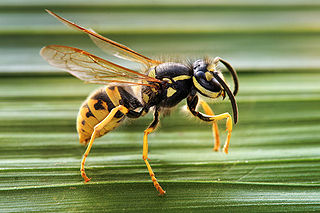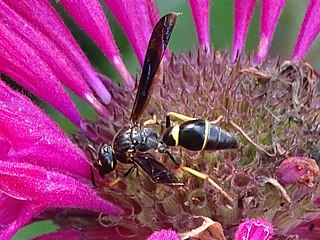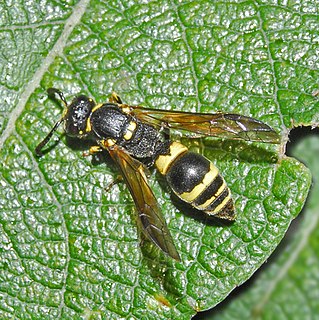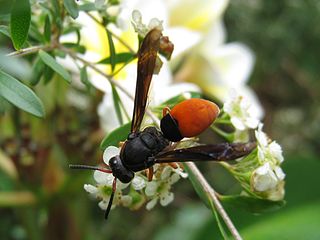
The Vespidae are a large, diverse, cosmopolitan family of wasps, including nearly all the known eusocial wasps and many solitary wasps. Each social wasp colony includes a queen and a number of female workers with varying degrees of sterility relative to the queen. In temperate social species, colonies usually last only one year, dying at the onset of winter. New queens and males (drones) are produced towards the end of the summer, and after mating, the queens hibernate over winter in cracks or other sheltered locations. The nests of most species are constructed out of mud, but polistines and vespines use plant fibers, chewed to form a sort of paper. Many species are pollen vectors contributing to the pollination of several plants, being potential or even effective pollinators, while others are notable predators of pest insect species, and a few species are invasive pests.

Potter wasps, the Eumeninae, are a cosmopolitan wasp group presently considered a subfamily of Vespidae, but sometimes recognized in the past as a separate family, Eumenidae.

Dolichovespula is a small genus of social wasps distributed widely throughout the Northern Hemisphere. The yellow and black members of the genus are known by the common name yellowjackets in North America, such as Dolichovespula norwegica, along with members of their sister genus Vespula. In a study on the nesting biology of Dolichovespula, a colony of D. maculata with 771 workers was reported as having the largest recorded population count.

Leptochilus is a large, mostly Holarctic genus of small sized potter wasps. The genus reaches its largest diversity in the Palearctic where there are more than 135 species belonging to 5 subgenera. However the division of The division of Leptochilus into subgenera can not be fully supported and the status of some of them is dubious.

Parazumia is a Neotropical and Nearctic genus of medium to large sized potter wasps. The Nearctic species of this genus have been treated for much of the 20th century as a separate genus named Paranortonia.

Pachodynerus is a fairly large neotropical and nearctic genus of potter wasps with higher diversity in central South America. At least one species has been introduced in other biogeographical regions, including several oceanic islands, while Pachodynerus erynnis occurs on Ascension Island as well as in North America. This genus is most closely related to the genus Euodynerus.

Delta is an Old World genus of potter wasps with species predominantly distributed through tropical Africa and Asia. Some species are present in the Palearctic region, and a few have been introduced in the Nearctic and Neotropical regions. The members of this genus have a long metasomal petiole, like members of the genera Eumenes and Zeta.

Symmorphus is a primarily holarctic genus of potter wasps.within the family Vespidae.
Postepipona is an Afrotropical genus of potter wasps containing two species, one from Madagascar and the other from island of Socotra in Yemen.

Pseudabispa is an Australian and Papuan genus of potter wasps containing 5 species, one of them subdivided in 4 subspecies.
Knemodynerus is a genus of potter wasps distributed through the Palearctic, Afrotropical, Indomalayan and Australasian regions. The species currently classified in the genus are:
Leptomenes is a mainly Afrotropical genus of potter wasps. It was previously a much larger genus, though many species have been transferred to other genera such as Eumenidiopsis, Stroudia, and Tachymenes.
Paravespa is an Afrotropical and Palearctic genus of potter wasps.
Labus is an Indomalayan genus of potter wasps. It contains the following species:
Mitrodynerus is a monotypic genus of potter wasps with the single member being endemic to Sri Lanka.
Paragymnomerus is a palearctic genus of potter wasps.
Parodontodynerus is a Palearctic genus of potter wasps.

Pseumenes is an Indomalayan, Australian and Palearctic genus of potter wasps.
Spinilabochilus is a Palearctic genus of potter wasps.
Tropidodynerus is a Palearctic and Indomalayan genus of potter wasps.









